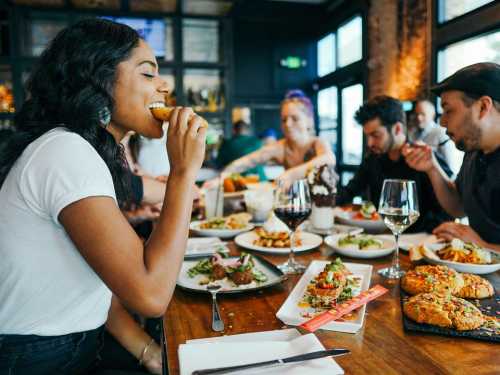
Each of us has witnessed, or perhaps participated in, awkward situations in a restaurant at least once. Mistakes are made not only by those who rarely go to establishments, but even by people who consider themselves experts in restaurant culture.
Raised conversations with the staff, inappropriate behavior at the table, unsuccessful attempts to split the bill – all this not only puts us in an awkward position, but also forms a certain impression of us in the eyes of others.
Restaurant etiquette is not about excessive formality, but about comfort, respect, and the ability to be a person with whom it is pleasant to be at the same table.
It all starts long before you even step foot in a restaurant. Making a reservation is not only a way to guarantee a seat at a popular establishment, but also a sign of respect for the restaurant and its staff.
In some cases, especially if it's a fine dining establishment or a popular evening spot, it's considered bad manners to show up without a reservation. This can make the staff feel uncomfortable and even make it seem like you're just a “go-to” establishment.
Once you have booked a table, it is important to stick to the appointed time. Being 10-15 minutes late is still forgivable, but if it is more, it would be a good idea to call and warn. In some restaurants, after 15-20 minutes of non-appearance, the reservation may be canceled, and if you show up with a surprised look, counting on a served seat, the situation will turn out to be awkward.
What to do if you don't like the table you're offered? You can ask to be moved, but without whims or irritation. For example, “if possible, we would prefer a table by the window” will sound respectful. But phrases like “we don't like it, we want to go there” may cause surprise among the staff.
There is a rule in the restaurant: talking to the staff is an art, not a privilege. Addressing them as “you”, shouting “hey, girl” or “young man” is a gross error. It is much more elegant and respectful to say: “Excuse me, can I have a moment?” or use neutral addresses: “Please, bring…”.
If the waiter is standing nearby, don't try to get his attention by waving your hands or snapping your fingers (it looks rude). A glance and a slight nod will suffice.
A separate topic is dialogues with waiters. If you don’t like something, criticism is acceptable, but in a correct form. Instead of: “what a terrible presentation?” it is better to say: “it seems that the dish is oversalted. Maybe this can be fixed?” Constructiveness is the key to good service and the absence of unpleasant consequences (after all, the waiter is your intermediary between you and the kitchen).
You need to read the menu carefully and without rushing. Asking, “What do you have?” is a gross etiquette blunder. Even worse is demanding something that is not on the menu. Some guests, inspired by scenes from films, try to show off their knowledge and order “something special from the chef.” In most cases, this looks inappropriate, although in fine dining restaurants, especially for regular customers, such a request may be appropriate if delicately discussed through the waiter. It is important not to confuse such an impromptu request with formal offers, such as a “chef’s menu” or a tasting set, where the guest consciously trusts the chef’s choice.
Ordering dishes for everyone is the right of either the host of the evening or the one who makes the offer, taking into account the preferences of the rest. The phrase: “I will choose for all of us” may be appropriate if you really know the tastes of the company. Otherwise, it is simply disrespectful. If you hesitate with the choice, you can clarify the waiter’s recommendations. However, the phrase “what do you recommend?” without specifying your preferences puts him in a dead end. It is better to be specific: “I like tender meat, what would you recommend?”
Ordering wine is a ritual. In good restaurants, it is chosen either by the host of the evening or by someone who knows more. When the sommelier brings the bottle, he shows the label not for beauty, but to make sure that you are served the right wine. Mistakes happen, and a nod of approval is a sign that the bottle is correct.
Next comes the tasting. No, not to assess whether you like the taste! But to check whether the wine has any defects. You can refuse if it is spoiled, but not because you did not like the taste.
Food is a test of your level of education. The main mistakes: talking with your mouth full, holding utensils incorrectly (knife in your right hand, fork in your left, unless you are left-handed), swinging cutlery, bending low over your plate.
Special attention should be paid to the behavior with bread: we break off a piece and bring it to our mouth, but we do not bite off the whole piece.
The finale of the evening is the art of paying the bill correctly. The one who invited pays the bill. If the initiative was joint, it is permissible to divide it, but discussing it loudly and demonstratively is bad form.
If one person pays, the others don't look at the check. This is considered impolite.
Tipping, although not formally obligatory, is a sign of appreciation for quality service and is expected in many cultures. In Ukraine, as in many other countries, the generally accepted norm for good service is 10%, and for excellent service – up to 15%. At the same time, it is worth remembering that this tradition is not universal: for example, in Japan, leaving a tip is considered offensive, and in some European countries a service charge may already be included in the bill.
If you pay by card, it is advisable to add the tip to the bill amount (if the terminal allows it) or leave it in cash.
Restaurant etiquette is not just a formality, but a way to make the evening comfortable and enjoyable. It allows you to avoid awkward situations, helps you make useful acquaintances and even affects the impression you leave about yourself. After all, being a person with whom it is easy and pleasant to be at the same table is a real art.
Джерело: ukr.media






